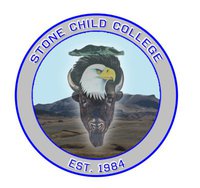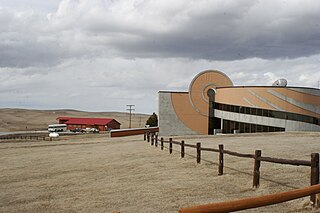
The Arapaho are a Native American people historically living on the plains of Colorado and Wyoming. They were close allies of the Cheyenne tribe and loosely aligned with the Lakota and Dakota.

Fort Washakie is a census-designated place (CDP) in Fremont County, Wyoming, United States, within the Wind River Indian Reservation and along U.S. Route 287. The population was 1,759 at the 2010 census. The headquarters for the Eastern Shoshone Tribe is located in Fort Washakie, as well as the Bureau of Indian Affairs agency for the Wind River Indian Reservation.
Northwest Indian College is a public tribal land-grant community college in Bellingham, Washington. It was established by the Lummi Nation and is the only accredited tribal college or university serving reservation communities of Washington, Oregon, and Idaho.

Fort Peck Community College (FPCC) is a public tribal land-grant community college in Poplar, Montana. The college is located on the Fort Peck Assiniboine & Sioux Reservation in the northeast corner of Montana, which encompasses over two million acres. The college also has a satellite campus in Wolf Point.

The Wind River Indian Reservation, in the west-central portion of the U.S. state of Wyoming, is shared by two Native American tribes, the Eastern Shoshone and the Northern Arapaho. Roughly 60 mi (97 km) east to west by 50 mi (80 km) north to south, the Indian reservation is located in the Wind River Basin, and includes portions of the Wind River Range, Owl Creek Mountains, and Absaroka Range.

Sitting Bull College (SBC) is a public tribal land-grant college in Fort Yates, North Dakota. It was founded in 1973 by the Standing Rock Sioux tribe of the Standing Rock Indian Reservation in south-central North Dakota. The SBC campuses are located in Fort Yates, North Dakota and McLaughlin, South Dakota. It serves as the primary educational institution on the Standing Rock Reservation.
Turtle Mountain Community College (TMCC) is a private tribal land-grant community college in Belcourt, North Dakota. It is located ten miles from the Canada–US border in Turtle Mountain, the north central portion of North Dakota. In 2012, TMCC's enrollment was 630 full- and part-time certificate and degree-seeking students.
United Tribes Technical College (UTCC) is a private tribal land-grant community college in Bismarck, North Dakota. In 2012, UTTC had an enrollment 885 students, 635 full-time undergraduates, and 250 part-time undergraduates.

Little Big Horn College is a public tribal land-grant community college on the Crow Indian Reservation in Crow Agency, Montana. It has an open admissions policy and welcomes enrollment from any adult with a high school diploma or GED. The student body is composed of Crow Tribal members, members of American Indian Tribes from around the intermountain west, and non-Indian residents of the Big Horn County area.

Bay Mills Community College (BMCC) is a public tribal land-grant community college in Brimley, Michigan. It is chartered by the federally recognized Bay Mills Indian Community of Michigan with a total enrollment of approximately 500 on-campus and online students. The students come primarily from Michigan's eastern Upper Peninsula and are 60% Native American. BMCC is a member of the American Indian Higher Education Consortium (AIHEC), a community of tribally and federally chartered institutions working to strengthen tribal nations, and a land-grant college.
Nebraska Indian Community College (NICC) is a public tribal land-grant community college with three locations in Nebraska: Macy on the Omaha Tribe reservation, Santee on the Santee Sioux reservation, and the urban South Sioux City.

Leech Lake Tribal College (LLTC) is a public tribal land-grant community college in Cass Lake, Minnesota. It was established in 1990 and designated a land-grant college in 1994. The college includes approximately 70 faculty, staff, administrators, and 250 students. Most students come from the Leech Lake and Red Lake Reservations, and approximately 8% of the student population consists of non-Indian students.

Chief Dull Knife College is a public tribal land-grant community college on the Northern Cheyenne Indian Reservation in Lame Deer, Montana. It is an open-admission college with about 141 students. On average, more than half of its graduates move on to four-year colleges.

Sinte Gleska University (SGU) is a public tribal land-grant university in Mission, South Dakota, on the Rosebud Indian Reservation. It is a Brulé Lakota Indian Reservation home to the Sicangu. SGU has an enrollment of 828 full and part-time students. It is regionally accredited by the Higher Learning Commission.

James Trosper is the current Eastern Shoshone Sun Dance chief. He is widely regarded as “a respected voice on traditional Plains Indian spirituality.” He is Director of the High Plains American Indian Research Institute. HPAIRI facilitates a wide variety of partnerships between the University of Wyoming and the tribes of the Wind River Indian Reservation in Fort Washakie, Wyoming “to work together in ways that empower tribes, nurture innovation for American Indian sustainability, and demonstrate respect for Native peoples’ cultures, traditions, laws, and diverse expressions of sovereignty.”
The Cheyenne and Arapaho Tribes are a united, federally recognized tribe of Southern Arapaho and Southern Cheyenne people in western Oklahoma.

Stone Child College (SCC) is a public tribal land-grant community college in Box Elder, Montana. SCC is affiliated with the Chippewa-Cree Tribe and located on the Rocky Boy Indian Reservation in north central Montana; it is one of seven Tribal Colleges in Montana. In 2008–09, SCC had an enrollment of 511, of whom 98 percent were American Indian descent; 20 percent were bilingual or of limited English proficiency. SCC students range in age from 17 to 72, with the average age at 30. The college retention rate is 47 percent and the graduation rate is 20 percent.
Navajo Technical University (NTU) is a public tribal land-grant university in Crownpoint, New Mexico, with sites in the towns of Chinle, Arizona and Teec Nos Pos, Arizona. NTU is the largest tribal college in the country and is a 1994 land grant university. It has been accredited by the Higher Learning Commission since 2005 and is home to the first accredited veterinary technician program on an Indian reservation.

Oglala Lakota College (OLC) is a public tribal land-grant community college in Kyle, South Dakota. It enrolls 1,456 students enrolled part- and full-time. OLC serves the Pine Ridge Indian Reservation, which has a population of about 26,000 and covers 3,468 square miles in southwestern South Dakota.

Friday (Arapaho: Teenokuhu or Warshinun, also known as Friday Fitzpatrick, was an Arapaho leader and interpreter in the mid to late 1800s. When he was around the age of eight, he was separated from his band and was taken in by a white trapper. During the next seven years, he was schooled in St. Louis, Missouri and went on trapping expeditions with his informally adopted father, Thomas Fitzpatrick. After he was recognized by his mother during an encounter with the Arapaho, he returned to the tribe.













